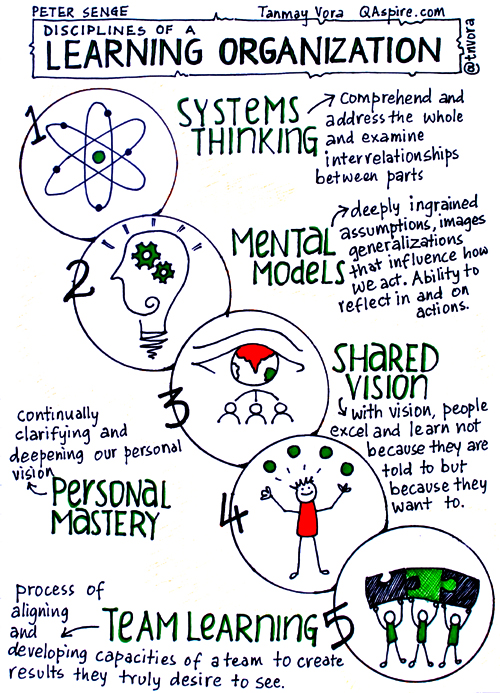Disciplines of a Learning Organization: Peter Senge
Tanmay Vora
If there is one book that has influenced my business thinking the most, it is Peter Senge’s “The Fifth Discipline – The Art and Practice of Learning Organization” and I have referred to it many times over past years on this blog. Written in 1990, the insights contained in this book are even more relevant today when the rate of change has only accelerated – probably a reason why HBR identified this book as one of the seminal management books of the previous 75 years.
A couple weeks ago, I posted a sketch note on “Why Organizations Don’t Learn?” based on an HBR article by the same title and someone ended up asking me,
“How do organization’s learn?”
This question immediately reminded me of five disciplines of learning organizations that Peter Senge outlines in this book. They are:
Source: Wikipedia
In the book, Peter Senge offers a wonderful analogy to introduce systems thinking:
A cloud masses, the sky darkens, leaves twist upward, and we know that it will rain. We also know that after the storm, the runoff will feed into groundwater miles away, and the sky will grow clear by tomorrow. All of these events are distant in time and space, if they’re all connected within the same pattern. Each has an influence on the rest, and influence that is usually hidden from view. You can only understand the system of rainstorm by contemplating the whole not any part of the pattern.
Businesses and other human endeavors are also systems. They, too, are bound by invisible fabrics of interrelated actions, which often take years to fully play out their effects on each other. Since we are part of that lacework ourselves, it’s doubly hard to see the whole pattern of change. Instead we tend to focus on snapshots of isolated parts of the system, and wonder why our deepest problems never seem to get resolved.
While the book is a must-read if you want to gather better understanding and context behind these disciplines, here is a short summary of five disciplines of a learning organization in form of a sketch note.
Hopefully, this will help others in acknowledging the foundation of what it takes to create a learning organization.

Related Posts at QAspire Blog: